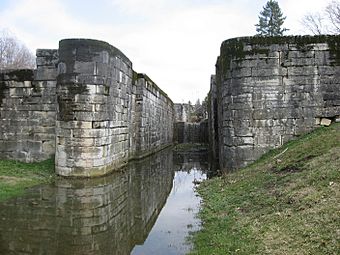Lockington Locks facts for kids
Quick facts for kids |
|
|
Lockington Locks Historical Area
|
|

Southern end of Lock One after a rainstorm
|
|
| Location | Miami and Erie Canal between Lockington and Washington Township |
|---|---|
| Nearest city | Lockington |
| Area | 45 acres (18 ha) |
| Built | 1833 |
| NRHP reference No. | 69000147 |
| Added to NRHP | December 17, 1969 |
The Lockington Locks are a cool set of canal locks located in Lockington, Ohio, United States. These locks were part of the old Miami and Erie Canal. Building them started in 1833, and they were ready for boats to use by 1845.
There are seven locks in total: six are grouped together, and one is a bit further south. The whole system, including places where boats could turn around, stretches for about 3.75 miles (6.04 km) (6 km) between Lockington in Shelby County and Washington Township in Miami County.
Contents
Building the Locks
Why Lockington Was Important
The Lockington Locks were built at the southern end of a long, flat section of the canal called the Loramie Summit. This summit stretched for about 21 miles (34 km) (34 km) north from Lockington to New Bremen.
Lockington was a very important spot on the canal. Besides its locks, the canal met Loramie Creek here. Originally, the canal crossed the creek using a special bridge for water, called an aqueduct.
Water Supply for the Canal
Lockington was also where a smaller canal joined the main line. This smaller canal brought a lot of water from the Lewistown Reservoir. This reservoir is near Ohio's highest point in nearby Logan County.
This extra water was needed because the Loramie Summit was the highest part of the canal, at 944 feet (288 m) (288 m) above sea level.
How Boats Used the Locks
As canal boats traveled north to Lockington, they needed to be lifted a total of 67 feet (20 m) (20 m) to reach the summit. Each lock lifted the boats a certain amount:
- Lock 48: 10 feet (3.0 m) (3 m)
- Lock 49: 11 feet (3.4 m) (3.4 m)
- Lock 50: 11 feet (3.4 m) (3.4 m)
- Lock 51: 11 feet (3.4 m) (3.4 m)
- Lock 52: 12 feet (3.7 m) (3.7 m)
- Lock 53: 12 feet (3.7 m) (3.7 m)
It usually took several hours for boats to pass through all these locks. Because of this, the village of Lockington was founded. It was first called "Locksport." The village provided services for the boatmen and passengers who had to wait.
Materials Used for Construction
The individual locks at Lockington were made from large limestone blocks. Some of these blocks weighed as much as 500 pounds (230 kg) (227 kg)! The floors of the locks were made of wood, and their gates were built from strong white oak wood.
The Locks Through Time
The canals in Ohio were most successful around 1855. After that year, they started to earn less money. This was because railroads became popular and offered a faster way to transport goods and people. Even small towns like Lockington soon had train stations.
Eventually, selling water became the main way the canal system made money. People tried to fix up the canal system in the 1900s. However, all efforts to restore it stopped after a huge flood in 1913. This flood destroyed many parts of the canal and ended any hope of using it for business again.
Today, the Lockington Locks and the land around them are a park. The only water flowing through the locks now is from heavy rains. The area around the locks is very pretty. There are plans to turn the old towpath, which was used by horses to pull boats, into a hiking trail.
Why the Locks Are Special
In 1969, the Lockington Locks were added to the National Register of Historic Places. This was a big deal because they were the first place in either Miami County or Shelby County to get this honor.
Other canal sites in both counties were later added to the Register:
- The Piqua Historical Area State Memorial in Miami County (1971)
- The Twin Arch Stone Culvert in Miami County (1978)
- The Turtle Creek Culvert and Embankment in Shelby County (1978), though it was removed seven years later.
The Lockington Locks were important enough to be listed because they were an amazing engineering achievement. They also played a big part in the history of Ohio and the entire country.




